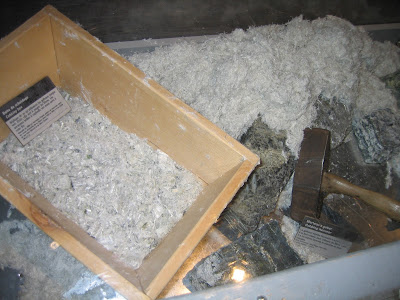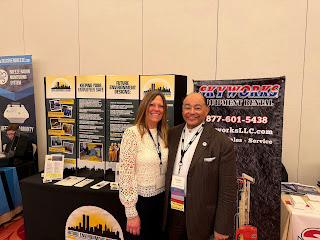In the construction world, one of the most pressing concerns for worker safety is the potential asbestos exposure. This hazardous material, once commonly used in various building materials for its fire-resistant and other properties, has been linked to serious health risks, including lung cancer, asbestosis, and mesothelioma. Asbestos exposure remains a significant threat, especially in older buildings undergoing renovation or demolition. The Environmental Protection Agency (EPA) and the Occupational Safety and Health Administration (OSHA) have set strict guidelines to minimize this danger, but compliance hinges on one key factor: thorough and accurate asbestos inspections.
To explore the intricacies of asbestos inspections, Angelo Garcia, III of Future Environment Designs, Inc., will be moderating a distinguished panel at PACNY's 2025 Environmental Conference on Thursday, February 27, 2025. The panel will dive deep into the importance and differences in asbestos inspections from various perspectives. This includes Tom Laubenthal of TGL Consulting and ASTM E2356 Chairman, who will discuss the ASTM asbestos inspection standard, Chris Alonge now with Dormitory Authority of the State of New York (DASNY) who will provide insights from an owner's perspective, Marc Rutstein from Environmental Consulting & Management Services, who will offer a consultant's viewpoint and highlight the differences between NYCDEP and NYSDOL inspections, and Matt Brooks from International Asbestos Removal (IAR), who will speak on the contractor’s perspective.
 |
| Asbestos pipe insulation with fitting insulation |
Asbestos inspections play a vital role in identifying materials that may contain asbestos before they are disturbed. This proactive approach not only prevents worker exposure but also ensures that proper abatement procedures are followed. A well-executed asbestos inspection is the first line of defense against the release of airborne asbestos fibers, which can be deadly when inhaled.
Understanding the Importance of Homogeneous Areas
At the heart of every asbestos inspection is the process of determining whether a material is classified as a surfacing material, thermal system insulation, or miscellaneous material. Once the material type is identified, the inspector must establish whether the materials are homogeneous. According to the EPA’s Asbestos Hazard Emergency Response Act (AHERA), a homogeneous area is defined as one where the material is uniform in color and texture.
 |
| Floor tiles and numerous homogeneous areas |
However, that is not the only definition of homogeneous area/material. For example, the American Society for Testing and Materials (ASTM) has established a Standard Practice for Comprehensive Asbestos Surveys (ASTM E2356-18) in this standard the definition of homogeneous area is surfacing material, thermal system insulation material, or miscellaneous material that is uniform in color and texture and apparent or known date of installation. The other definitions that are used by inspectors also include some reference to installation or formulation in addition to color and texture. This classification is crucial because it informs the number of samples that must be taken to accurately assess the presence of asbestos.
Sampling Procedures: The Foundation of a Successful Inspection
For surfacing materials, the size of the homogeneous area directly influences the number of samples needed. Under the EPA’s guidelines, inspectors follow the “3-5-7 rule.” This means that three samples are required for areas smaller than 1,000 square feet, five samples for areas between 1,000 and 5,000 square feet, and seven samples for areas larger than 5,000 square feet. Additionally, the EPA’s “Pink Book,” formally known as Asbestos in Buildings: Simplified Sampling Scheme for Friable Surfacing Materials, recommends taking nine samples per homogeneous area, regardless of the square footage, for increased accuracy.
 |
| Asbestos Fireproofing |
For thermal system insulation, the process differs slightly. Inspectors must determine if the material is homogeneous, patch material, or material used on fittings like elbows and valves. Homogeneous areas of thermal system insulation require three samples, while patch materials smaller than six linear or square feet only need one sample (the only time one sample is allowed). Cement or plaster used on fittings must be sampled based on the specific mechanical system in question, and a minimum of two samples is required for each system. However, the EPA in A Guide to Performing Reinspections Under AHERA strongly advises taking at least three samples in larger homogeneous areas, even if regulations don't mandate it.
For materials such as joint compound and add-on materials, however, the EPA’s “Asbestos Sampling Bulletin dated September 30, 1994” specifies that three samples are required for each material. These distinctions are critical for asbestos inspectors to ensure compliance and accuracy in their assessments (see our original blog post on asbestos surveys).
In May 2007, the EPA provided important clarification on sampling requirements. Mr. Chris Alonge, at the time, was working for New York State Department of Labor (NYSDOL) and he requested clarification regarding the number of samples that should be taken for each suspect asbestos-containing homogeneous miscellaneous material. The clarification was distributed by the Professional Abatement Contractors of New York (PACNY) in November 2007. According to this clarification, the minimum number of samples that should be taken of miscellaneous materials (i.e., floor tiles, roofing, caulk, ceiling tiles) is two (see our original blog post on this issue).
 |
| Respirator and protective clothing should be worn by the inspector during sampling |
Following proper sampling protocols is crucial because asbestos is considered present if any one of the samples from a homogeneous area contains more than 1% asbestos. Conversely, if all samples return asbestos concentrations at or below 1%, the area is deemed asbestos-free—though it’s important to remember that materials containing 1% or less of asbestos are still regulated under OSHA’s asbestos standard (see the Varga letter).
The Legal and Health Implications of Incomplete Inspections
Inadequate or incorrect asbestos inspections can have severe consequences. From a legal standpoint, failing to adhere to EPA and OSHA regulations can result in hefty fines and penalties. Remember neither regulation has a specific end date for buildings not containing asbestos (see our post Is There an Appropriate End Date for Asbestos Use?). More importantly, from a health perspective, improperly identifying or failing to identify asbestos-containing materials (ACMs) can expose construction workers to dangerous fibers, leading to long-term health problems. Given that asbestos-related diseases may take decades to develop, the human cost of negligent inspections can be devastating.
 |
| The closet door with asbestos core was cut without any precautions costing over $30,000 to clean up the contamination. |
Mr. Tom Laubenthal wrote EPA in November 2014 regarding The Standard Practice for Comprehensive Asbestos Surveys (ASTM E2356-18) Pre-Construction Survey (section 8 of the standard) meeting the requirement under National Emissions Standards of Hazardous Air Pollutants (NESHAPS) of a thorough inspection. EPA responded that they would expect an owner/operator to follow the steps in Sections 1 through 5 and Section 8 to comply with the NESHAPS regulation. This standard provides a framework for conducting thorough asbestos inspections, particularly in pre-construction scenarios, ensuring that no asbestos-containing material goes unnoticed.
Conclusion: The Essential Role of Inspections
Asbestos inspections are the cornerstone of any effort to protect workers from exposure to this hazardous material. By adhering to the EPA’s and OSHA’s strict sampling and inspection guidelines, inspectors can identify asbestos-containing materials before they are disturbed, reducing the risk of airborne fibers and subsequent health issues. Given the serious implications of asbestos exposure, thorough inspections are not just a regulatory requirement—they are a moral imperative in safeguarding the health and well-being of workers.
 |
| Asbestos Floor Tiles disturbed before identification led to a clean-up costing over $250,000 |
In the end, the responsibility lies with all stakeholders—building owners, contractors, and asbestos inspectors alike—to ensure that every construction or renovation project is free from asbestos hazards. As inspectors, staying current on regulations, maintaining rigorous sampling standards, and educating clients on the risks and regulations associated with asbestos are critical components in this ongoing battle against a deadly substance.
The asbestos inspection panel promises to be an invaluable session for professionals across the construction, consulting, and regulatory industries. With these diverse viewpoints, we aim to shed light on the critical role inspections play in protecting workers and ensuring compliance with ever-evolving asbestos regulations. Asbestos inspections are not just about checking boxes—they are about saving lives.









































